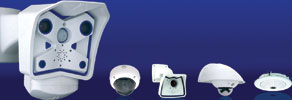

The lens can make a dramatic difference when it comes to HD video surveillance.
Video surveillance systems have to cope with scenes with often-changing light conditions. The illumination of outdoor scenes in particular can vary from bright sunlight to complete darkness. CCD sensors used in analogue as well as in digital video cameras cannot handle bright sunlight. When overexposed, they tend to exhibit vertical white stripes due to bleeding. The CCD sensors can even physically deteriorate when exposed to bright sunlight for longer periods of time without protection.
Conventional solution
Analogue video cameras solve this problem by a lens design that uses an auto iris. An auto iris is a diaphragm with electrically adjustable aperture. The aperture is formed by several motor-driven blades controlled by a signal, which in turn is derived from the analogue video signal.
The use of an auto iris imposes several drawbacks:
* Moving parts are prone to fail. By using a motor-driven device, reliability and robustness are adversely affected.
* Varying the aperture changes depth of field. An image might look focused at high illumination since the camera uses a low aperture and thus has a high depth of field. However, as illumination decreases, the aperture opens and depth of field decreases, leading to a larger image area that is out of focus.
* When applying the auto-iris lens design to digital video cameras, this creates even more counter-productive effects as the shape of the diaphragm influences the appearance of blurred image areas. Low-quality diaphragms with fewer blades result in unnatural out-of-focus image areas. This effect becomes more dominant as the resolution of the image sensor increases, eg, for megapixel digital video cameras.
* Most cameras with auto iris implement a basic exposure control, averaging brightness over the total image area in order to maintain a constant level of light on the image sensor. In critical exposure situations, eg, with backlighting, darker areas become even darker and faces cannot be recognised any more.
These drawbacks prompted an iris-free lens design.
Iris-free lens design
Mobotix has taken a completely different approach to solving the problem:
* Mobotix uses digital CMOS sensors that do not exhibit bleeding as CCD sensors do.
* In addition, the digital CMOS sensors used in Mobotix cameras do not need to be exposed at a constant level of light to provide a good image. Instead, exposure is controlled digitally from 1/8000th of a second to 1 second.
Since Mobotix cameras are using an iris-free lens design, they do not suffer from the drawbacks and limitations imposed by an auto iris, ie, Mobotix cameras have no moving parts that can fail or lock in fluctuating temperatures. Without any moving parts, they are therefore so robust that maintenance is reduced to a minimum. The temperature range from -30°C to +60°C is achieved without heating or fan at only 3 watts. Since no PC hard disk is required for recording, there are no parts that wear out in the entire video system.
Mobotix cameras implement the iris-free lens design by applying a sophisticated software-based exposure control algorithm. This algorithm relies on exposure windows that are drawn on specific areas of the image. The exposure control algorithm uses these exposure windows to maintain good exposure. Without the auto iris, the camera can electronically choose what to see. Mobotix cameras are not affected adversely by sunlight such as direct sunlight. They deliver meaningful, detailed images all the time, because the camera software supports easy programming of exposure windows to cope with specific situations.
Auto-iris lens design is a relic from analogue technology. Its use involves drawbacks and even impairs high-resolution megapixel digital video cameras. By using a digital CMOS sensor combined with software-based exposure control, iris-free lens design guarantees optimal image exposure and outperforms conventional lens designs that are relying on auto-iris exposure control.
| Tel: | +27 12 657 3600 |
| Email: | [email protected] |
| www: | www.iacontrol.co.za |
| Articles: | More information and articles about Industrial Automation & Control (IAC) |

© Technews Publishing (Pty) Ltd. | All Rights Reserved.